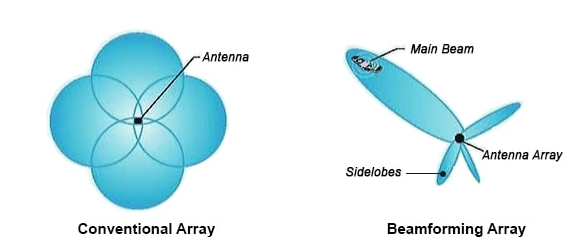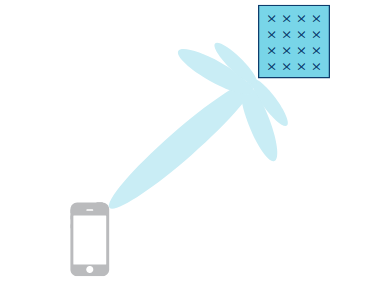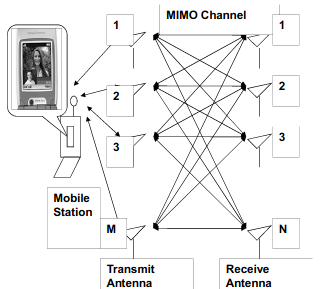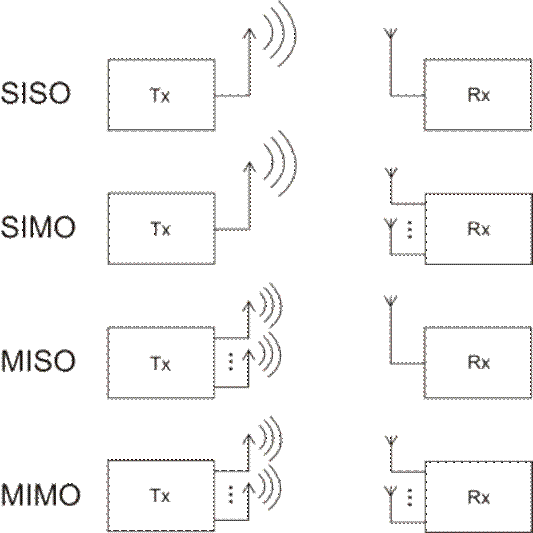Intro
Traditional multiple-input multiple-output (MIMO) systems may have two or four, some may even have eight antennas, and this has been adopted in some early systems such as 3G and 4G communication systems. Large MIMO systems, often referred to as massive MIMO systems, can be defined as those that use tens or hundreds of antennas in the communication terminals. Massive MIMO systems combined with beamforming antenna array technologies are expected to play a key role in next-generation wireless communication system (5G).
This article aims to briefly summarize the architecture and principles of MIMO radio and antenna array technology to achieve beamforming and improved QoS using software-steered radio signals, along with the key improvements from 4G to 5G in MIMO radio, smart antenna, and channel width area.
Beamforming and Antenna Array
Beamforming is a technique by which an array of antennas can be steered to transmit radio signals in a specific direction. Rather than simply broadcasting energy/signals in all directions, the antenna arrays that use beamforming, determine the direction of interest and send/receive a stronger beam of signals in that specific direction.

Beamforming adapt the radiation pattern of the antenna array to a particular scenario, that relative amplitude and phase shifts are applied to each antenna element to allow for the output signals from the antenna array to coherently add together for a particular transmit/receive angle and destructively cancel each other out for other signals.


This technique is widely used in radars and sonar, biomedical, and particularly in communications (telecom, Wi-Fi), specially 5G – Where very high data rates are required and the only way to support this would be to maximize transmit and receive efficiency by using beamforming. The phase of the signal is controlled by a Beamforming IC, such that a software could control the steering of directional antennas.
Besides of supporting on beamforming, the systems with MIMO offers high QoS (Quality of Service) with increased spectral efficiency and data rates.
RF Improvements from 4G to 5G
IMT 2020 identifies three major use cases for 5G in advanced RF technologies
| RF Technology | Description |
|---|---|
| Enhanced Mobile Broadband (eMBB) | Provides extremely high data rates (of up to 20 Gb/s) and offers enhanced coverage, well beyond that of 4G |
| Massive Machine Type Communicatoins (mMTC) | Designed to provide wide-area coverage and deep indoor penetration for hundreds of thousands of IoT devices per square kilometre. mMTC is also designed to provide ubiquitous connectivity for devices with limited processing capabilities. Also supports battery-saving low-energy operation. |
| Ultra-Reliable and Low Latency Communications (URLLC) | Ultra-Reliable and Low Latency Communications (URLLC) |
Following table is a clear comparison between RF technology in 4G and 5G, regarding of the antenna type, frequency band, radiation patterns, and polarization.
| Cellular standards | 4G | 5G |
|---|---|---|
| Antenna type | Subwavelength antennas | Phased array antennas |
| Frequency band | around 600 MHz, 700 MHz, 1.7/2.1 GHz, 2.3 GHz, and 2.5 GHz | millimeter wave 24.25 GHz to 52.60 GHz |
| Radiation patterns | Omnidirectional | Directional fan-beam |
| Diversity and MIMO | Yes | Yes |
| Polarization | Single and constant | Multiple and reconfigurable |
Advantages of MIMO Smart Antennas
The different forms of antenna technology refer to single or multiple inputs and outputs. These are related to the radio link. In this way the input is the transmitter as it transmits into the link or signal path, and the output is the receiver. It is at the output of the wireless link.
The different forms of single/multiple antenna links are defined as below:
- SISO: Single Input Single Output
- SIMO: Single Input Multiple Output
- MISO: Multiple Input Single Output
- MIMO: Multiple Input Multiple Output

Following are the benefits of MIMO
- The higher data rate can be achieved with the help of multiple antennas and spatial multiplexing technique. This helps in achieving higher downlink and uplink throughput.
- It helps in achieving reduction in BER (Bit Error Rate) due to application of advanced signal processing algorithms on the received data symbols by multiple antennas.
- The techniques such as STBC (Space Time Block Coding) and BF (Beamforming) when employed in MIMO system helps in achieving extension of cell coverage.
- MIMO based system minimize fading effects seen by the information traveling from transmit to receive end. This is due to various diversity techniques such as time, frequency and space.
- There is lower susceptibility of tapping by unauthorized persons due to multiple antennas and algorithms.
- The systems with MIMO offers high QoS (Quality of Service) with increased spectral efficiency and data rates.
- The wide coverage supported by MIMO system helps in supporting large number of subscribers per cell.
References
[1] Claire Masterson. Massive MIMO and Beamforming: The Signal Processing Behind the 5G Buzzwords.
[2] Advantages of MIMO. https://www.rfwireless-world.com/Terminology/Advantages-and-Disadvantages-of-MIMO.html
[3] What frequency spectrum will 5G technology use and how does this compare to 4G?. https://www.arrow.com/en/research-and-events/articles/what-frequency-spectrum-will-5g-technology-use-and-how-does-this-compare-to-4g
[4] 5G vs. LTE: What’s the difference, and does it matter?. https://www.digitaltrends.com/mobile/5g-vs-lte/
[5] Understanding of SISO, SIMO, MISO and MIMO. https://www.evercomtech.com/msg/msg8.html